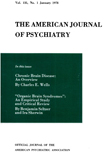Abstract
1. Sixty infantry soldiers, 55 Negro and 5 white, were studied to determine the basis for their addiction to marihuana.
2. Case histories reveal a background of psychopathic development and behavior.
3. Eighty-five percent of these men were referred for psychiatric evaluation because of poor records as soldiers, and the remainder for neurosis.
4. Median average age of the men was 22.4 years, and the median average length of service was 5.9 months. Only 2 men had desirable army records.
5. Thirty-eight or 63% had a history of homes broken in childhood by death, desertion or separation. Another 13 or 22% also had home environments where quarreling, domestic strife among parents was common.
6. Thirty-five percent were the only child in the family and 28% either the youngest or oldest in a large family.
7. Thirty-four of the men came from poverty-stricken levels.
8. Patients' memories of parents revealed 95% had mothers with high standards of morality and 68% had fathers of poor moral character.
9. Early childhood memories were of definite emotional strain, as revealed by frequent nightmares, history of enuresis, sleep disturbances, dizzy spells.
10. Only 11 of the men had gone as far as high school, although intelligence tests showed them all to be of normal intelligence.
11. Typical school behavior was one of truancy, arguing or fighting with teachers, gambling, sex promiscuity, associating with undesirable companions.
12. Work history shows a similar trend of psychopathic development with frequent changes of jobs and much unemployment, little desire to work. Marihuana was used frequently during work to relieve monotony.
13. Fifty had criminal records. Marihuana was used to furnish confidence but it was not the cause of criminal activity.
14. Strong abnormal sexual desires were present with an overlay of anxiety. Marihuana was used to remove anxiety and result was an over-emphasis on sexual pleasures on various levels of infantile sexuality.
15. Addicts associate only with other addicts and non-addicts are avoided. Recognition of other addicts is primarily by use of slang terms.
16. First attempts to contract the marihuana habit are believed to cause startling experiences but the user soon is able to control dosage and accustom himself to the drug to a degree sufficient to allay anxiety.
17. Six on 13% began use of the drug prior to adolescence; 29 or 64% started in the adolescent years, and the rest in early and late twenties. Median average length of addiction was 6 years.
18. Subjective effects of marihuana are described as tending to restore confidence, remove anxiety and eliminate physical pain.
19. Use of other stimulants with marihuana was common but marihuana is used as the primary pleasure. Quantity of marihuana cigarettes smoked daily is an individual matter but the majority used from 4 to 6 daily.
20. None of the men had any desire to be cured. Because of this, as well as their psychopathic background, prognosis for treatment is poor. They are a problem not only to the Army, but as patients in the Army hospital.
21. The personality pattern of these men is one of strong libidinous desires resulting from early home conflict, a weak ego which identifies with an undesirable father image, and a superego created by the moral mother. The superego is unable to prevent undesirable behavior but is able to create intense anxiety. Use of marihuana removes the superego which in turn strengthens the ego and enables it to satisfy the libidinous desires at various levels of infantile behavior. Homosexuality is evident in many of these men.

